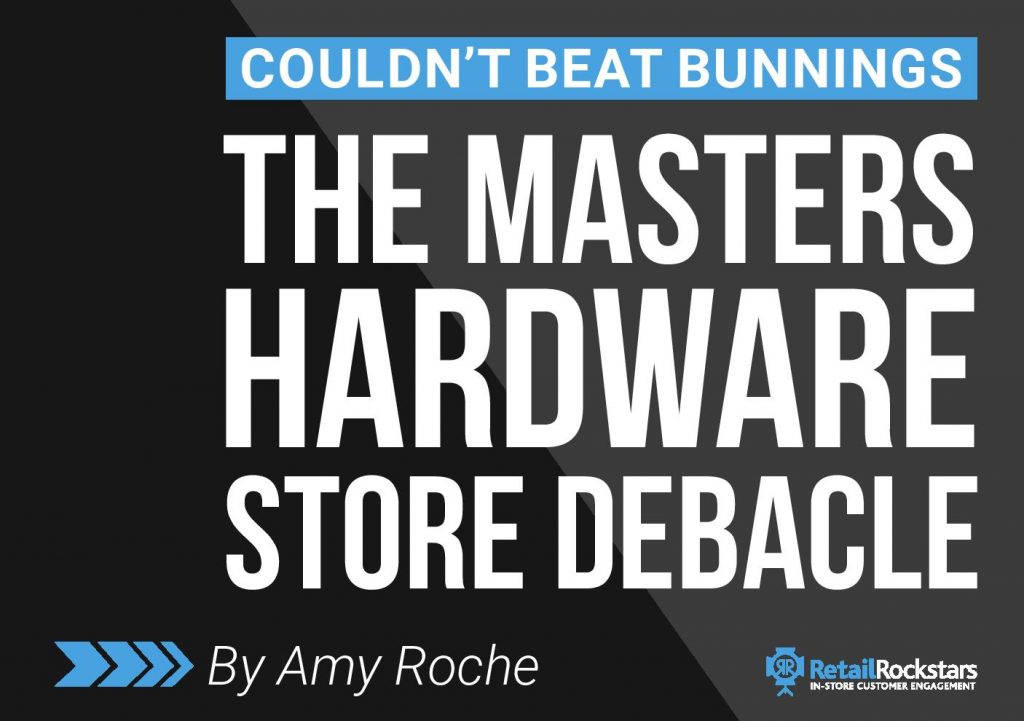Masters closing down was pretty significant for Australia, with a lot of things going against them from the start. Probably the largest and most evident was the fact that consumers already had an established hardware offering and Masters failed to deliver any differentiation to what Bunnings had already been delivering.
However, another huge mistake was underestimating Bunnings and their experiential retailing expertise.
Reaching Your Customers Through Experiential Retailing
A pioneer of experiential retailing in Australia, Bunnings learned early the power of in-store experience and used it effectively to deepen ties with customers, build reciprocity and of course keep their customers highly engaged.
While this may sound somewhat devious, it is exactly the opposite. Rather than focus all of their marketing dollars on push advertising and luring customers into their stores for deals only, they strategically placed more importance on making customers comfortable in their stores, offered education and even a bit of relaxation if not only temporarily from the rat race.
Offering a play area for the kids with cafes nearby meant the customer could stop and have a coffee break. If you’ve ever been to one of those little cafes it is quite the intimate little customer hot spot. I’ve sat there many times while my child plays on the playground.
Most retailers keep their staff in hiding but Bunnings have taken a different stance, whereby many staff stop off for lunch and breaks right in the café. While there’s no denying these are huge retail spaces, customers interacting with staff in cafés tend to make it feel a bit more like the Bunnings family, rather than a large multi-national retail brand.
While café’s and play areas are not all that unique, Bunning’s didn’t stop there. Another thing they really exceed at is their in-store educational workshops. These workshops were developed for kids, for everyday adults as well as specialised workshops for their trade business.
So while Masters was busy touting their customer service, range and prices on TV commercials, Bunnings were interacting and giving back to their customer’s valuable knowledge and expertise as well as getting them comfortable with being in-store longer.
Corporate Sterile Environments Do Not Breed Retail Success
Masters, on the other hand, was a fairly sterile environment. It was air-conditioned and clean, but they definitely didn’t have the personality and experience that Bunnings stores have. It just wasn’t part of their culture or their store offering. In the end, if they would have presented customers with a better option, better in-store experience, workshops or anything of note, the Australian consumers would have stood up to take notice and possibly embraced them.
Differentiation is the Key for a New Company on the Block
If you are going to come into a marketplace as the new retailer on the block, you better be adding some kind of differentiation and value back to your customers.
For example, offer a whole raft of in-store experiences on a whole different level. Masters could have even used Bunnings successful workshops, which obviously helped them build tons of engaged customers across the country. Instead, they came to the market thinking they were going to just take market share off of Bunnings with no real grounds for differentiation.
In summary, while the debacle has been all wrapped up for some time now. Both new and current retailers could all learn from this valuable retailing experiment.
While retailers still need to keep top of mind, customers need and want experiences in-store. They crave human connection and interaction. Simply having a clean new store with excellent customer service is not enough.
Give your customers inspiration for a new hobby, give them a reason WHY they could live healthier, be more environmental or give back to a cause you’re passionate about. Show them your personality and why your brand promise is so important. Not sure what your customer experience personality is? Take our FREE QUIZ and find out.
Additional Free Resources
For a deeper look at how you can inject more in-store experience and events into your retail store, check out articles “5 Key Elements to Produce a Successful LIVE Event for Your Customers” or “How LIVE events can Increase Sales and Customer Loyalty“.
Want a little more? Here are some ways we can help, download the first 3 chapters to my Book, The Retail Experiment, 5 proven strategies to Engage and Excite Customers through in-store experience. Or buy the book -direct through our site or through Amazon or Booktopia.
Or you might like to book a free Customer Experience Assessment, a 45 minute (Zoom), 7 point assessment of your brand experience across assets of your choice and, in turn, I’ll give you 3 easy to implement experiences that will drive sales and foot traffic.
Alternatively, if you’d like to discuss your upcoming Experience project, just email me or book in here.




